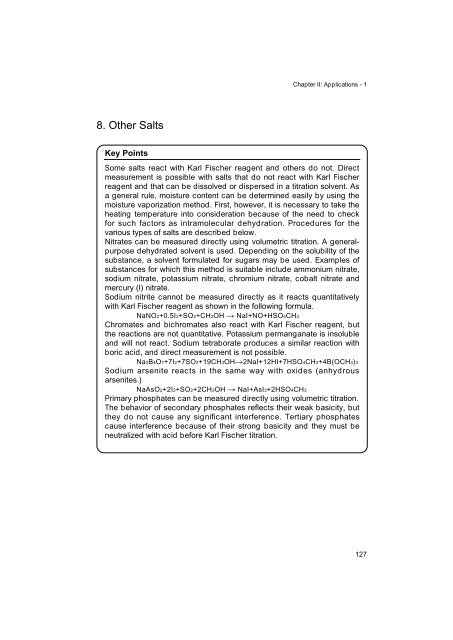Development of Karl Fischer Reagents
Development of Karl Fischer Reagents
Development of Karl Fischer Reagents
You also want an ePaper? Increase the reach of your titles
YUMPU automatically turns print PDFs into web optimized ePapers that Google loves.
8. Other Salts<br />
Key Points<br />
Chapter II: Applications - 1<br />
Some salts react with <strong>Karl</strong> <strong>Fischer</strong> reagent and others do not. Direct<br />
measurement is possible with salts that do not react with <strong>Karl</strong> <strong>Fischer</strong><br />
reagent and that can be dissolved or dispersed in a titration solvent. As<br />
a general rule, moisture content can be determined easily by using the<br />
moisture vaporization method. First, however, it is necessary to take the<br />
heating temperature into consideration because <strong>of</strong> the need to check<br />
for such factors as intramolecular dehydration. Procedures for the<br />
various types <strong>of</strong> salts are described below.<br />
Nitrates can be measured directly using volumetric titration. A generalpurpose<br />
dehydrated solvent is used. Depending on the solubility <strong>of</strong> the<br />
substance, a solvent formulated for sugars may be used. Examples <strong>of</strong><br />
substances for which this method is suitable include ammonium nitrate,<br />
sodium nitrate, potassium nitrate, chromium nitrate, cobalt nitrate and<br />
mercury (I) nitrate.<br />
Sodium nitrite cannot be measured directly as it reacts quantitatively<br />
with <strong>Karl</strong> <strong>Fischer</strong> reagent as shown in the following formula.<br />
NaNO2+0.5I2+SO2+CH3OH � NaI+NO+HSO4CH3<br />
Chromates and bichromates also react with <strong>Karl</strong> <strong>Fischer</strong> reagent, but<br />
the reactions are not quantitative. Potassium permanganate is insoluble<br />
and will not react. Sodium tetraborate produces a similar reaction with<br />
boric acid, and direct measurement is not possible.<br />
Na2B4O7+7I2+7SO2+19CH3OH�2NaI+12HI+7HSO4CH3+4B(OCH3)3<br />
Sodium arsenite reacts in the same way with oxides (anhydrous<br />
arsenites.)<br />
NaAsO2+2I2+SO2+2CH3OH � NaI+AsI3+2HSO4CH3<br />
Primary phosphates can be measured directly using volumetric titration.<br />
The behavior <strong>of</strong> secondary phosphates reflects their weak basicity, but<br />
they do not cause any significant interference. Tertiary phosphates<br />
cause interference because <strong>of</strong> their strong basicity and they must be<br />
neutralized with acid before <strong>Karl</strong> <strong>Fischer</strong> titration.<br />
127




